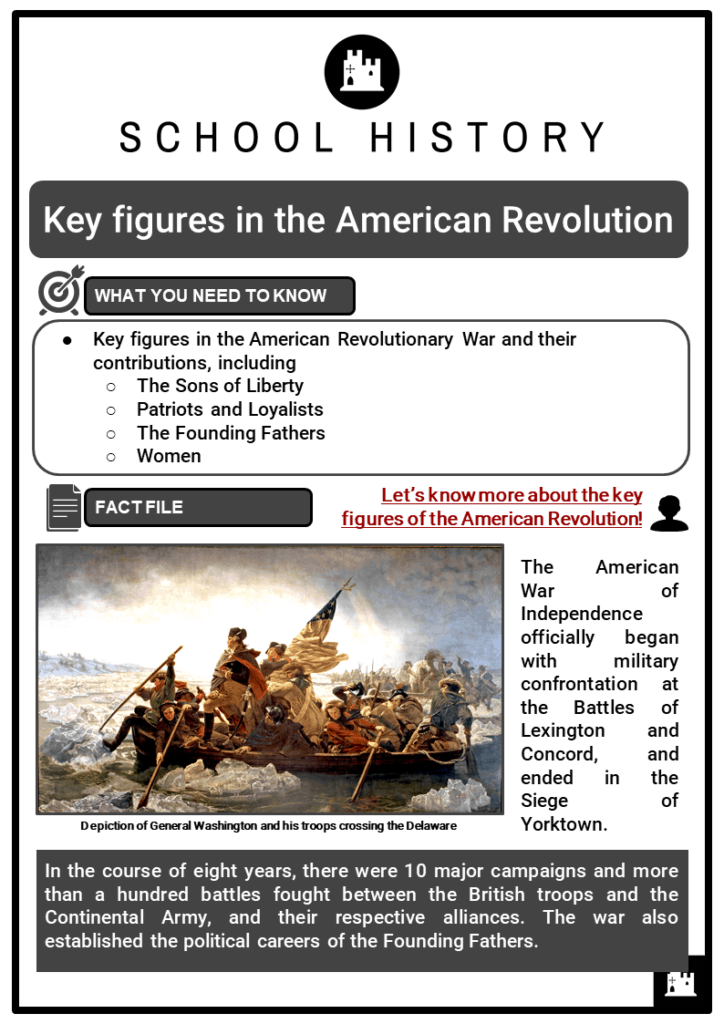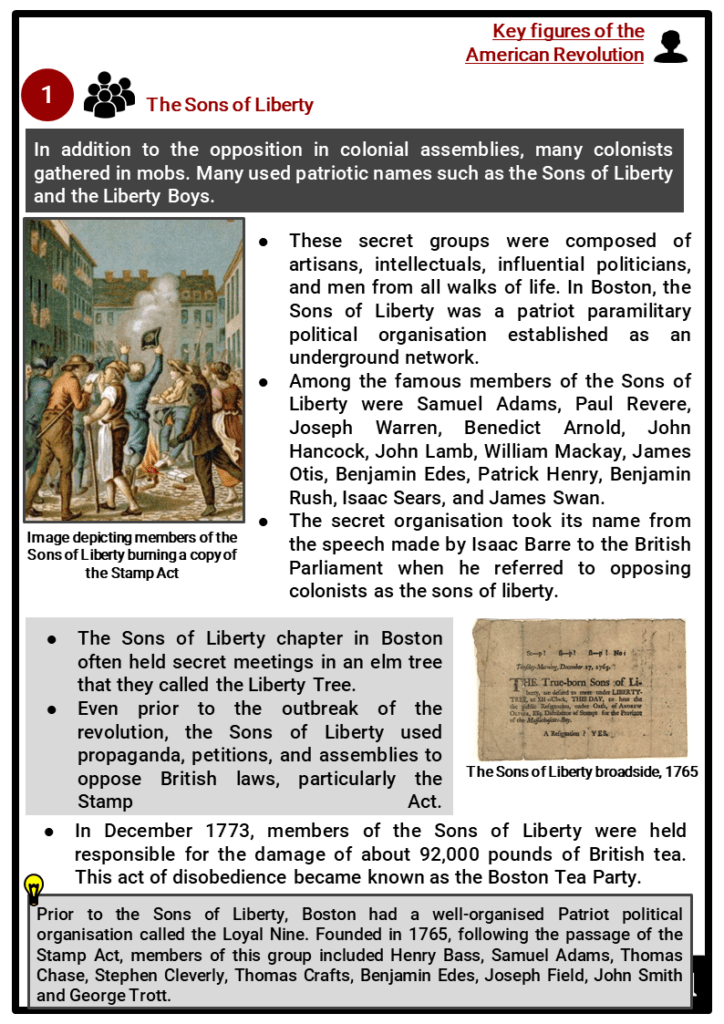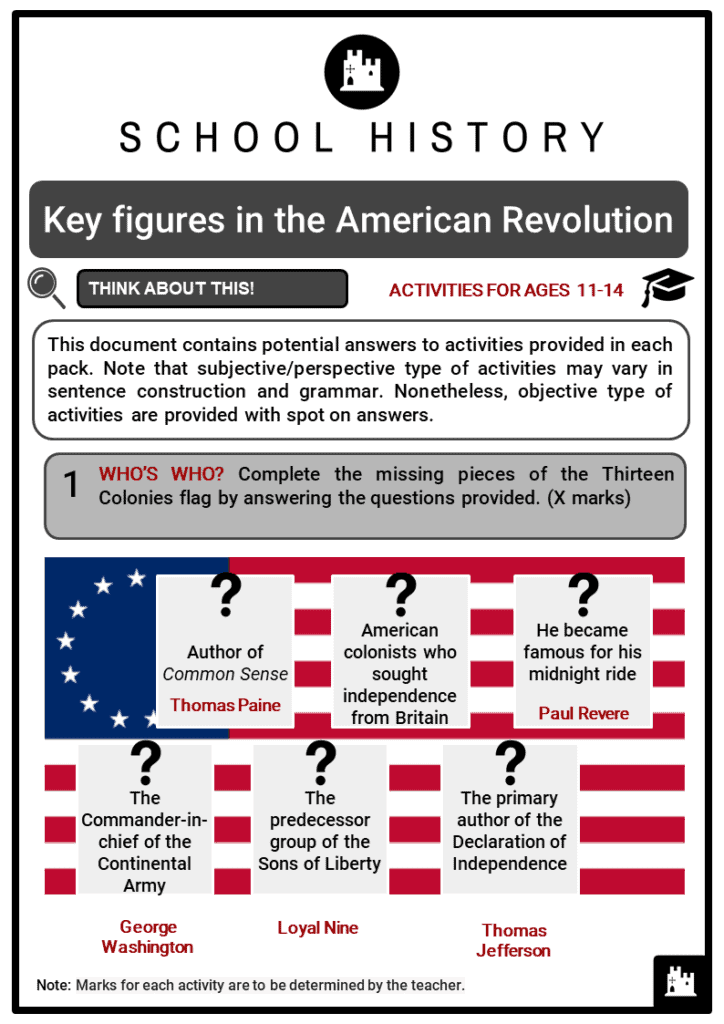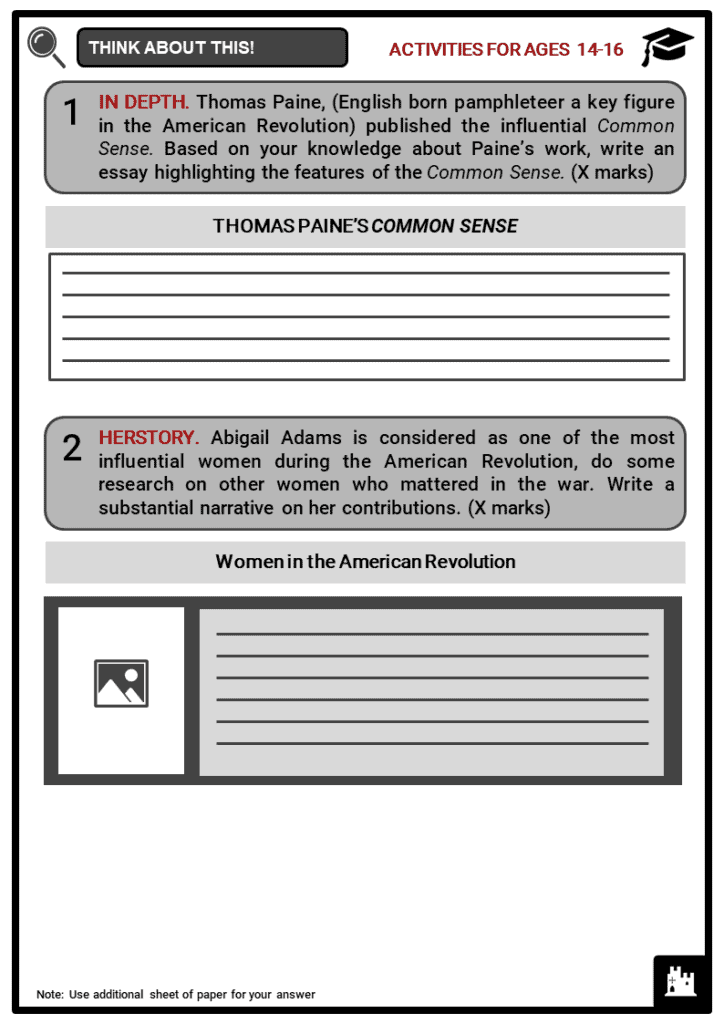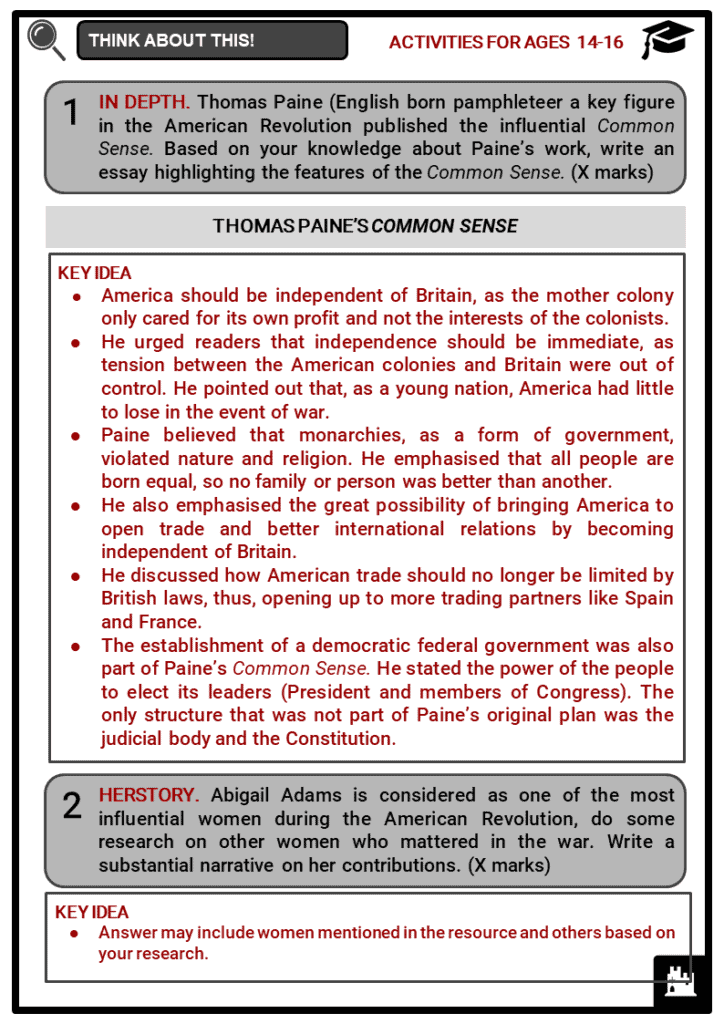Download Key Figures in the American Revolution Worksheets
Do you want to save dozens of hours in time? Get your evenings and weekends back? Be able to teach Key Figures in the American Revolution to your students?
Our worksheet bundle includes a fact file and printable worksheets and student activities. Perfect for both the classroom and homeschooling!
Table of Contents
Add a header to begin generating the table of contents
Summary
- Key figures in the American Revolutionary War and their contributions, including
- The Sons of Liberty
- Patriots and Loyalists
- The Founding Fathers
- Women
Key Facts And Information
Let’s know more about the key figures of the American Revolution!
- The American War of Independence officially began with military confrontation at the Battles of Lexington and Concord, and ended in the Siege of Yorktown.
- In the course of eight years, there were 10 major campaigns and more than a hundred battles fought between the British troops and the Continental Army, and their respective alliances. The war also established the political careers of the Founding Fathers.
Key figures of the American Revolution
The Sons of Liberty
- In addition to the opposition in colonial assemblies, many colonists gathered in mobs. Many used patriotic names such as the Sons of Liberty and the Liberty Boys.
- These secret groups were composed of artisans, intellectuals, influential politicians, and men from all walks of life. In Boston, the Sons of Liberty was a patriot paramilitary political organisation established as an underground network.
- Among the famous members of the Sons of Liberty were Samuel Adams, Paul Revere, Joseph Warren, Benedict Arnold, John Hancock, John Lamb, William Mackay, James Otis, Benjamin Edes, Patrick Henry, Benjamin Rush, Isaac Sears, and James Swan.
- The secret organisation took its name from the speech made by Isaac Barre to the British Parliament when he referred to opposing colonists as the sons of liberty.
- The Sons of Liberty chapter in Boston often held secret meetings in an elm tree that they called the Liberty Tree.
- Even prior to the outbreak of the revolution, the Sons of Liberty used propaganda, petitions, and assemblies to oppose British laws, particularly the Stamp Act.
- In December 1773, members of the Sons of Liberty were held responsible for the damage of about 92,000 pounds of British tea. This act of disobedience became known as the Boston Tea Party.
- Prior to the Sons of Liberty, Boston had a well-organised Patriot political organisation called the Loyal Nine. Founded in 1765, following the passage of the Stamp Act, members of this group included Henry Bass, Samuel Adams, Thomas Chase, Stephen Cleverly, Thomas Crafts, Benjamin Edes, Joseph Field, John Smith and George Trott.
Patriots v. Loyalists
- Patriots and loyalists were American colonists who differed in their beliefs and causes in joining the Revolutionary War.
- Patriots were colonists from the original thirteen colonies who rebelled against the British rule. They were members and supporters of the First and Second Continental Congress who supported the colonial representation and later on American independence from Britain.
- Prominent Patriots included Patrick Henry, Samuel Adams, Thomas Jefferson, Alexander Hamilton, Benjamin Franklin, George Washington, and John Hay. Most were regarded as the Founding Fathers.
- Also known as Tories or Royalists, Loyalists were American colonists who supported the British rule during the Revolutionary War. They mobilised their own Loyalist regiments to support and aid British troops, while others directly joined the army.
- Historians suggest that one-third of the colonists were sympathetic to the British. Those who openly proclaimed their loyalty to the Crown were expelled from their communities.
- Many took refuge in Quebec, a former French province turned British dominion.
- After the Revolutionary War, the majority of Loyalists fled to Britain, Canada, and Nova Scotia to avoid persecution, harassment and discrimination.
- First published in May 1754 through the Pennsylvania Gazette, Benjamin Franklin (a Patriot) used the Join or Die political cartoon to unify American colonies during the French and Indian War. After the passage of the Stamp Act, Franklin’s political cartoon was adopted by colonists against Britain.
The Founding Fathers
- The success of the American War of Independence was highly attributed to the Founding Fathers, who are believed to have united the original thirteen colonies to fight against the British rule. Most members were wealthy landowners and businessmen.
- GEORGE WASHINGTON
- During the French and Indian War, Washington fought for the British. He was a wealthy Virginian plantation and slave owner who began to resent the British crown due to imposition of taxes on the colonies.
- In 1775, the Congress appointed him as the commander of the Continental Army. Following the end of the war, Washington became the first president of the United States of America.
- ALEXANDER HAMILTON
- Born as an illegitimate son, Hamilton struggled in his early years. As a teenager, he emigrated to New York from the British West Indies and served as an aid to Washington during the Revolutionary War.
- In 1787, he wrote the Federalist Papers and pushed for the Constitution’s ratification. Under Washington, he served as the first Secretary of the U.S. Treasury and created the national bank.
- BENJAMIN FRANKLIN
- Also known as an inventor, scientist, printer, and diplomat, Franklin was appointed as one of the five members of the Declaration Committee.
- Moreover, he was the main negotiator who sealed the alliance with France during the war and the Treaty of Paris in 1783.
- JOHN ADAMS
- Along with Franklin, John Adams served in the Committee of Five and negotiated for the Treaty of Paris.
- In 1788, after diplomatic roles, Adams became Washington’s Vice President for two terms. In 1797, he was elected as the second U.S. President.
- SAMUEL ADAMS
- Cousin of John Adams, Sons of Liberty leader, Samuel Adams most likely planned the 1773 Boston Tea Party.
- In 1775, the attempted arrest of Adams might have sparked the Battles of Lexington and Concord. After the war, he served as Governor of Massachusetts.
- THOMAS JEFFERSON
- Virginian lawyer Thomas Jefferson primarily drafted the Declaration of Independence in 1776 and wrote the phrase that “all men are created equal”. His clause on the state of slavery was deleted in the final draft of the declaration.
- He served as Washington’s Secretary of State. In 1801, he was elected as the third President of the United States.
- JAMES MADISON
- Also from Virginia, Madison (who participated in the 1787 Constitutional Convention) drafted the U.S. Constitution that stipulated the division of federal power into three branches. Known as the Father of the Constitution, Madison co-authored the Federalist Papers.
- In 1808, he served as the fourth President of the United States after serving as Jefferson’s Secretary of State.
- Other prominent figures included: John Jay, a lawyer and diplomat who also negotiated for the Treaty of Paris and served as the first Chief Justice of the Supreme Court; John Hancock, who served as the President of the Continental Congress; Thomas Paine, author of the influential Common Sense; Paul Revere, member of the Sons of Liberty known for his midnight ride; and Patrick Henry, a Patriot known for his Give me liberty or give me death speech.
Other Influential Figures of the Revolution
Thomas Paine’s Common Sense
- Born in England in 1737, Thomas Paine was a school teacher and pamphleteer. He was a known supporter of American independence and published a 47-page pamphlet in 1776 titled ‘Common Sense’. Initially, the influential pamphlet was published anonymously.
Key features of Common Sense?
- America should be independent of Britain, as the mother colony only cared for its own profit and not the interests of the colonists.
- He urged readers that independence should be immediate, as tensions between the American colonies and Britain were out of control. He pointed out that, as a young nation, America had little to lose in the event of war.
- Paine believed that monarchies, as a form of government, violated nature and religion. He emphasised that all people are born equal, so no family or person was better than another.
- He also emphasised the great possibility of bringing America to open trade and better international relations by becoming independent of Britain.
- He discussed how American trade should no longer be limited by British laws, thus, opening up to more trading partners like Spain and France. America would also no longer be stuck in the middle of wars between Britain and its rivals.
- In the first year of publication, about 25 editions of Common Sense were legally printed. Given the relatively small population of 4 million, about 150,000 copies were sold, which made it a colonial bestseller. Months later, Thomas Jefferson, one of the authors of the Declaration of Independence, used the pamphlet as a template and source of ideas.
- The establishment of a democratic federal government was also part of Paine’s Common Sense. He stated the power of the people to elect its leaders (President and members of Congress). The only structure that was not part of Paine’s original plan was the judicial body and the Constitution.
- Paine’s publication was a success, partly due to the fact that he wrote in plain language that enabled many people to understand it.
- Scholars regard Common Sense as the publication that sparked the fight for colonial independence.
Abigail Adams and other women in the war
- Some historians suggest that there should be Founding Mothers. These include women who were significantly influential over the course of the Revolutionary War.
- Wife of Massachusetts delegate John Adams, Abigail reminded her husband in Philadelphia to remember the ladies. She particularly wrote in a letter: “...remember the ladies, and be more generous and favorable to them than your ancestors. Do not put such unlimited power into the hands of the Husbands...”
- Mary Ludwig Hays, commonly known as Molly Pitcher, earned fame at the Battle of Monmouth in 1778. Initially, she was tasked to bring soldiers water, but she ended up replacing her husband in the artillery.
- Margaret Corbin, wife of another artillery man, became the first American female to receive a lifetime pension after the Revolutionary War. She fought at Fort Washington in 1776.
- Phillis Wheatley became the first female and first African American woman to be published. She wrote poetry about patriotism and human virtues. Commander of the Continental Army, George Washington even read Wheatley’s personal poem in 1776. By 1778, she gained freedom upon the death of her master.

